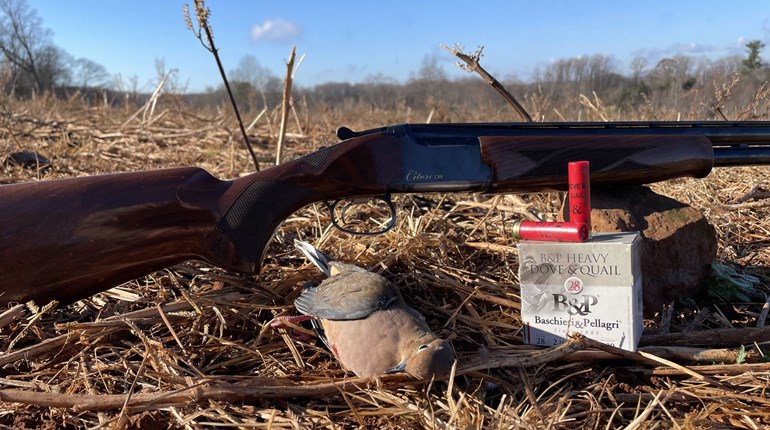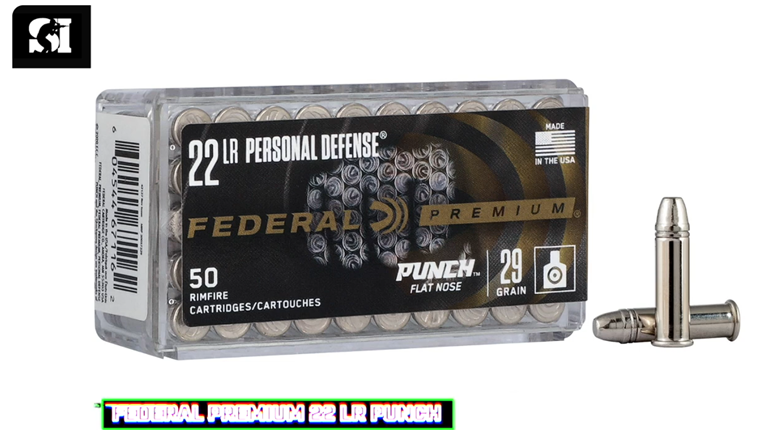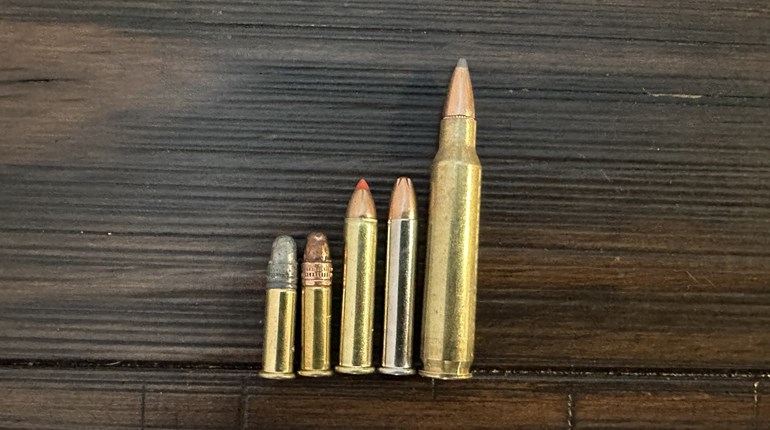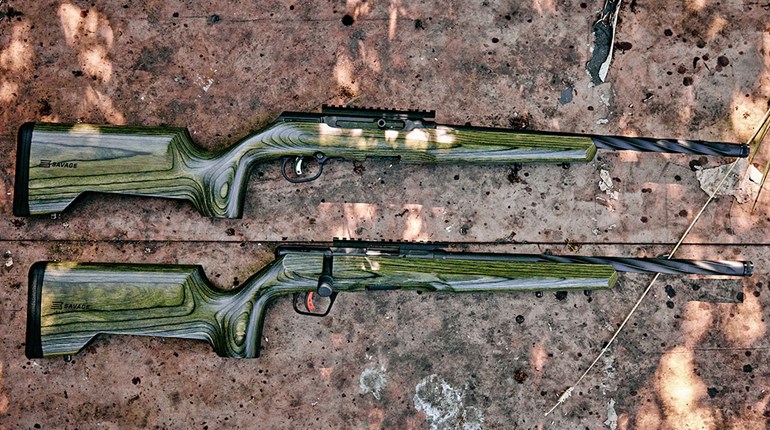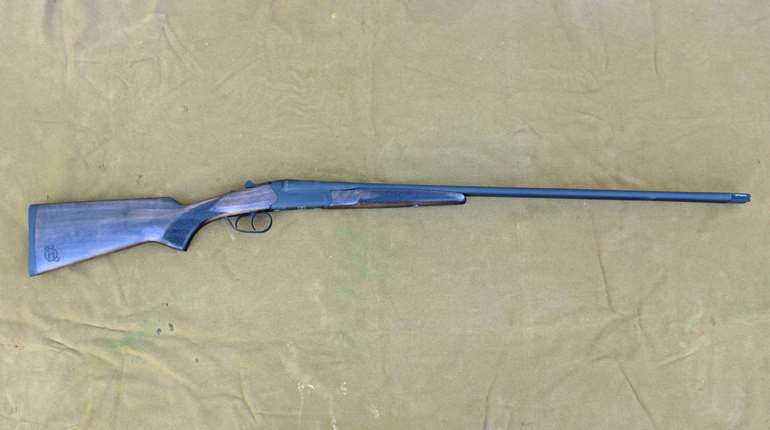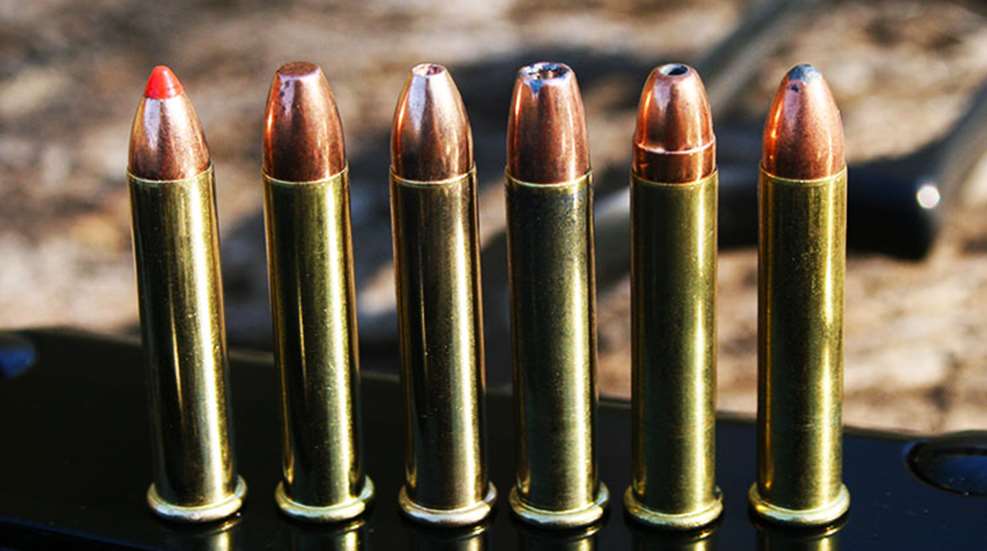
Introduced in 1959, the .22 Winchester Magnum Rimfire (22 WMR) is the quintessential ranch rifle round. The “.22 Mag,” as it’s less colloquially coined, delivers external and terminal ballistics sufficient to rid the pasture, woodlot and garden of marauding varmints, pests and predators out to 150 yards. When a quality rifle is placed in the hands of accomplished marksmen, that distance can be stretched a bit further. Despite the .22 Magnum’s uptick in external ballistics over the .22 Long Rifle (22 LR), perceived recoil is virtually nonexistent, making it ideal for multi-day prairie dog and ground squirrel shoots. Shooter fatigue with the cartridge is purely fictional.
Further endearing the .22 WMR to homeowners with neighbors is its reduced report; unless ultra-long volleys are commonplace, it’s unlikely that the sound will burden either the nearby residents or livestock within earshot. Ammunition is surprisingly affordable and diverse, too. In fact, 50-round boxes of ammunition in wide-ranging configurations range from $10.99 to $17.99 at MidwayUSA. Given such an assortment—the abovementioned retailer lists 26 different loads on its website—and price range, how do you know what to select? That’s the intent of this article—to provide an unbiased perspective.
In the subsequent paragraphs, I describe the particulars of six current .22 WMR hunting loads, as well as each load’s performance with regard to accuracy from a bench rest at 100 yards (five consecutive, five-shot groups), velocity and terminal performance at 50 yards in modeling clay. Velocities were recorded using a Competition Electronics ProChrono Digital 15 feet from the 20 ½-inch barrel of the test rifle, a Henry Repeating Arms Lever Action Octagon Frontier topped with a Bushnell Banner 3-9X40 riflescope. Bear in mind that as a lever-action rifle, the Henry was incapable of illustrating functionality of the ammunition in a semi-automatic, .22 WMR-chambered arm, and inherent accuracy shouldn’t be judged solely based on results from a single rifle, either. Lastly, I noted the advantages and drawbacks associated with each load. Here are my discoveries.
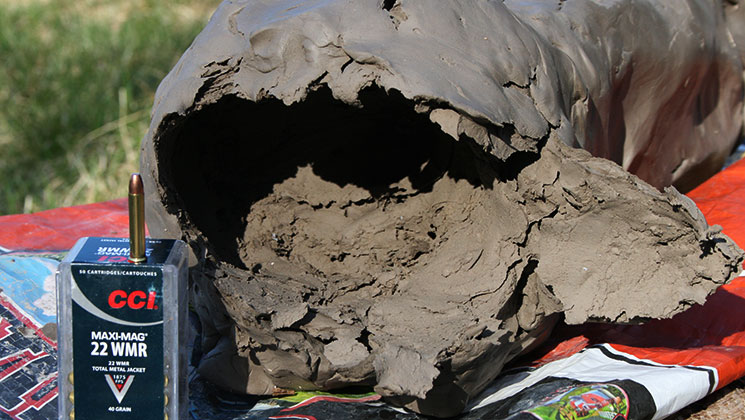
1. CCI Maxi-Mag .22 WMR 40-Grain Total Metal Jacket
Particulars: Featuring a full metal jacket, 40-grain bullet propelled to 1875 fps—for 312 ft.-lbs. of energy—this load was designed primarily for plinking and perforating paper; however, it’d nicely pull double-duty for those who want neutralize varmints or even dispatch porkers. Concerning the latter, from the field reports that I’ve read it’s the cat’s meow for exterminating feral hogs—to each their own. MSRP: $11.79 per 50-rnd. box; midwayusa.com.
Test: Across a Competition Electronics ProChrono Digital chronograph at 15 feet, the load averaged 1768 fps. Concerning accuracy, the flat-point, no-lead-exposed bullets proved to be near the top of the heap. In fact, for five consecutive, five-shot groups, it averaged 1.11-inch. The single smallest group measured 0.78-inch. As for its performance in the modeling clay, forget everything that you know about TMJ bullets—it doesn’t apply here. This bullet expands violently; weighing 33.4 grains, the recovered bullet measured an impressive 0.702-inch in diameter. Still, penetration was fairly deep.
Advantages: Eye-opening terminal ballistics, accurate, low cost, no-lead-exposed bullet.
Drawbacks: Looking for a non-expanding bullet to minimize pelt damage? This isn’t it.
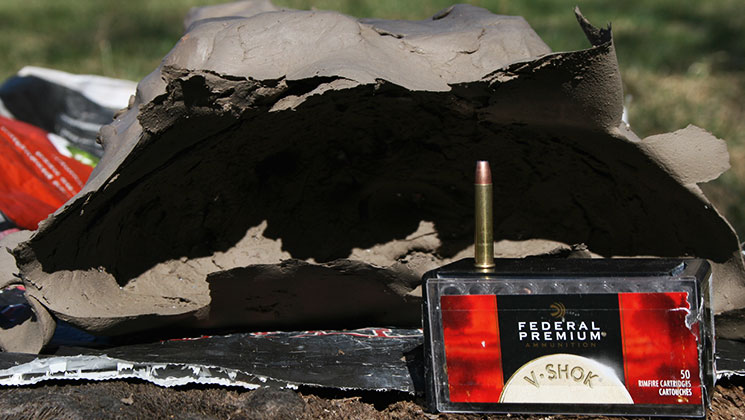
2. Federal Premium V-Shok 30-Grain Speer TNT
Particulars: This devastating round employs Speer’s appropriately named “TNT” bullet; pairing a lead core and thin jacket in a cavernous, hollow-point configuration maximizes expansion while simultaneously reducing penetration—perfect for stopping critters on the spot and reducing the risk of ricochet. Enhancing the external and terminal ballistics of the 30-grain bullet, its speedy 2200 fps velocity resulting in 322 ft.-lbs. of energy at the muzzle. MSRP: $12.99 per 50-rnd. box; midwayusa.com.
Test: Despite the test rifle’s 20½-inch barrel, this load achieved 2147 fps—only 53 fps less than the velocity achievable from a full 24-inch barrel. Accuracy with this round was respectable, averaging 1.39 inches for the 25 shots. Terminal performance in the modeling clay could be summed up with one word: devastating. The bullet created an immense yet relatively shallow cavity and completely fragmented. It’s little wonder why so many hunters report instantaneous kills on game upward the size of coyote.
Advantages: Shocking terminal performance, good accuracy, reasonable cost, reduced risk of ricochet.
Drawbacks: Want deep penetration? Look elsewhere.
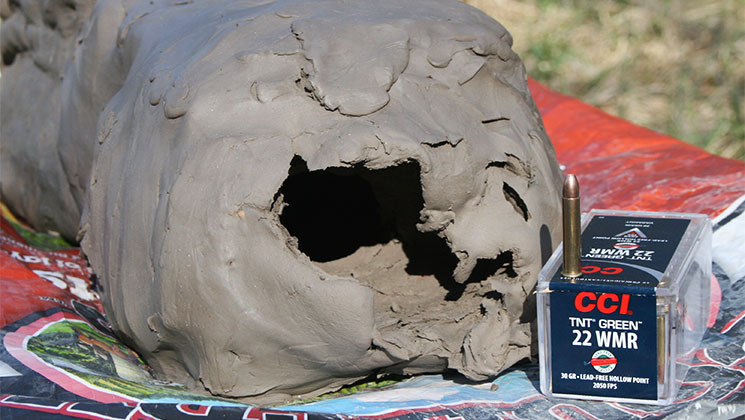
3.CCI TNT Green .22 WMR 30-Grain Lead-Free Hollow Point
Particulars: This is one of the few lead-free options in .22 WMR. It features a California compliant, 30-grain hollow-point bullet propelled to 2050 fps. Energy is 280 ft.-lbs. MSRP: $15.99 per 50-rnd. box; midwayusa.com.
Test: Taking into account its lightweight, 30-grain bullet, the recorded velocity of 1960 fps revealed that this is no speedster. That has little effect on its terminal performance, though. In fact, the projectile created a sizeable and surprisingly deep wound channel in which it fully fragmented, leaving the once-compressed core material strewn about. With such expansion characteristics, ricochets would be highly unlikely. The load’s strong showing with regard to terminal performance was somewhat offset by its accuracy potential; in the Henry it averaged 1.95 inches, which is large for extended-range work on smallish species.
Advantages: Lead-free (California compliant), good terminal ballistics.
Drawbacks: Pricey, lackluster accuracy.
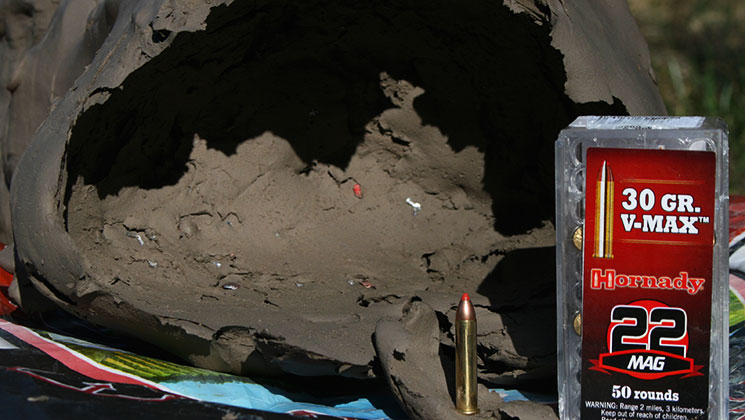
4. Hornady 30-Grain V-Max
Particulars: The unabashed long-range option of this assemblage, this load employs Hornady’s 30-grain, polymer-tipped V-Max bullet propelled to 2200 fps, making it ideal for stretching the distance on wary varmints and predators. In addition to increasing the ballistic coefficient (BC) for improved external ballistics, the tip ensures explosive expansion even at the reduced velocities at distance. Recovery distances will be short—if the animals move at all. Energy is 322 ft.-lbs. As an aside, this bullet has a lead core, therefore it’s not California compliant for hunting; however, Hornady manufactures a lead-free option in its 25-grain NTX load. MSRP: $11.69 per 50-rnd. box; midwayusa.com.
Test: Averaging 2166 fps, the Hornady 30-grain V-Max load was the fastest of the group. It was also the most accurate; in fact, the average for five consecutive, five-shot groups was a remarkable 0.94-inch. The single smallest group measured a diminutive 0.21-inch. Between its speed and accuracy, this is the go-to round for stretching the distance. True to its lineage, the 30-grain V-Max bullet proved to be extremely explosive in the modeling clay; only a few shards of the jacket and core and the tip were recovered.
Advantages: Extremely accurate, fast, excellent terminal performance, reduced risk of ricochet, low cost.
Drawbacks: None
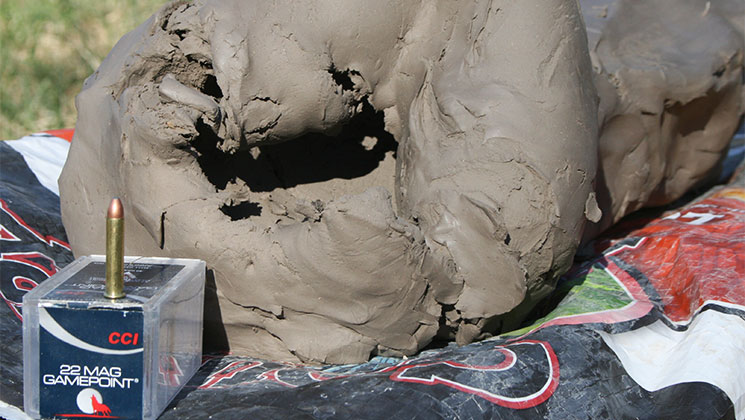
5. CCI .22 Mag GamePoint 40-grain Jacketed Soft Point
Particulars: Unique in this grouping, the GamePoint load—marketed as a small-game load—features a 40-grain, jacketed, soft-point bullet, which is designed for controlled expansion and deep penetration. Said characteristics will endear it to pursuers of larger, tougher predators, such as coyotes. Propelled to 1875 fps, the bullet produces 312 ft.-lbs. of energy at the muzzle. MSRP: $12.99 per 50-rnd. box; academy.com.
Test: At 1915 fps, the Competition Electronics chronograph revealed that this load was slightly faster than the published velocity. Accuracy wise, the load did good but not great; for 25 shots it averaged 1.65-inch. What stands out about this load is its terminal performance. Constructed more like a big-game bullet than one for varmints, the recovered bullet weighed 39.9 grains—virtually 100 percent weight retention. Moreover, the bullet, which measured 0.545-inch in diameter, created a large wound cavity and penetrated deep. For coyotes and other large nuisance species within the .22 Magnum’s realm, there’s none better.
Advantages: Deep-penetrating, high-weight-retention bullet (perfect for larger animals within the cartridge’s capabilities), descent accuracy, moderate cost.
Drawbacks: More likely to ricochet than the more fragile bullets.
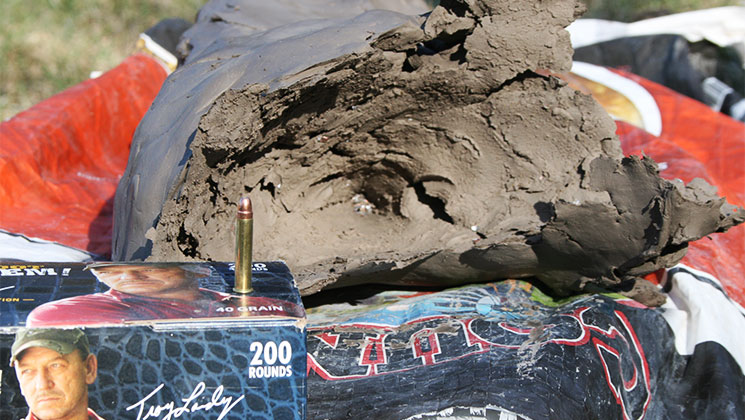
6. CCI Maxi-Mag .22 WMR 40-Gr. Jacket Hollow Point
Particulars: Ah, yes, the omnipresent Maxi-Mag .22 WMR load; perhaps none is as so persuasive. The 40-grain, copper-plated-lead, hollow-point bullet is pushed to 1875 fps, for 312 ft.-lbs. of energy. Designed for small game and varmints—think utilitarian—the projectile offers controlled expansion for deep(ish) penetration. Because of its terminal performance, though, only with headshots should it be utilized on edible game. MSRP: $11.79 per 50-rnd. box; midwayusa.com.
Test: This load clocked 1759 fps from the Henry’s abbreviated barrel. Concerning accuracy, at 1.90-inch for it left much to be desired; you’ll struggle to make consistent hits on small species at the 22 WMR’s farthest reaches. The load offered a useful blend of terminal ballistics. Only the GamePoint and TMJ loads out-penetrated the Maxi-Mag 40-grain JHP bullet, and the cavity it produced was sizable. Given the recovered projectile expanded to 0.438-inch in diameter and weighed 17.5 grains, a sizeable portion of the bullet pierced deep while the washed off material would naturally serve to damage vital organs and structures.
Advantages: Utilitarian bullet design, low cost
Drawbacks: Unimpressive accuracy
The .22 WMR is a top-notch cartridge for eliminating nuisance animals at ranges out to 150 yards. However, its maximum potential is unlocked only through load selection. Here you’ve been introduced to six options among the many in the marketplace. One of them will help you extract the most from your “.22 Mag.”












